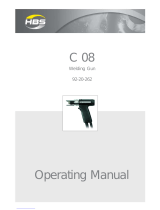
B-7B-7
OPERATION
MAKING A WELD
1. Check that the electrode polarity is correct for the process
being used, then turn the power switch ON.
2. Set desired arc voltage and wire speed for the particular
electrode wire, material type and thickness, and gas (for
GMAW) being used. Use the Application Chart on the door
inside the wire compartment as a quick reference for some
common welding procedures.
3. Select the desired mode as described in "Description of
Controls” Section.
4. Press the trigger to feed the wire electrode through the
gun and cable and then cut the electrode within
approximately 3/8" (10 mm) of the end of the contact tip
[3/4" (20 mm) Outershield
®
].
NOTE: If set for slow run-in when the trigger is pulled, the
wire feeder feeds wire at low speed regardless of the set wire
feed speed until the welding arc starts or 1 second has
elapsed. This feature enhances starting and makes it easier
to set the stickout. The 1 second limit permits high speed
loading of the gun and cable. To change run-in mode, see
"Run-In Mode" in Description of Controls Section.
5. If welding gas is to be used, turn on the gas supply and set
the required flow rate (typically 25-35 CFH; 12-16
liters/min).
6. When using Innershield electrode, the gas nozzle may be
removed from the insulation on the end of the gun and
replaced with the gasless nozzle. This will give improved
visibility and eliminate the possibility of the gas nozzle
overheating.
7. Connect work cable to metal to be welded. Work clamp
must make good electrical contact to the work. The work
must also be grounded as stated in "Arc Welding Safety
Precautions".
When using an open arc process, it is necessary
to use correct eye, head, and body protection.
------------------------------------------------------------------------
8. Position electrode over joint. End of electrode may
be lightly touching the work.
9. Lower welding helmet, close gun trigger, and begin
welding. Hold the gun so the contact tip to work
distance is about 3/8" (10 mm) [3/4" (20 mm) for
Outershield].
10. To stop welding, release the gun trigger and then
pull the gun away from the work after the arc goes
out.
11. When no more welding is to be done, close valve on
gas cylinder (if used), momentarily operate gun trig-
ger to release gas pressure, and turn off
POWER
MIG
®
256.
AVOIDING WIRE FEEDING
PROBLEMS
Wire feeding problems can be avoided by observing the
following gun handling procedures:
• Do not kink or pull cable around sharp corners.
• Keep the gun cable as straight as possible when weld-
ing or loading electrode through cable.
• Do not allow dolly wheels or trucks to run over cables.
• Keep cable clean by following maintenance instruc-
tions.
• Use only clean, rust-free electrode. The Lincoln elec-
trodes have proper surface lubrication.
• Replace contact tip when the arc starts to become
unstable or the contact tip end is fused or deformed.
• Keep wire reel spindle brake tension to minimum
required to prevent excess reel over-travel which may
cause wire "loop-offs" from coil.
• Use proper drive rolls and wire drive idle roll pressure
for wire size and type being used.
FAN CONTROL
The fan is designed to come on automatically when a
weld arc is established. The fan will stay on for a minimum
of 6 minutes after the weld arc is terminated. The fan will
also stay on when the machineʼs welding and feeding are
disabled during thermostatic over temperature protection.
(See Welding Thermal Overload Protection)
INPUT LINE VOLTAGE PROTECTION
High Line Voltage — If the line voltage exceeds 125% of
rated input voltage, the output will be reduced to the lower
level to protect voltage rating of the capacitor bank.
Low Line Voltage — You may not be able to get
maximum output from the machine if the line voltage is
less than rated input. The unit will continue to weld, but
the output may be less than what is set.
WIRE FEED OVERLOAD PROTECTION
The
POWER MIG
®
256 has solid state overload
protection of the wire drive motor. If the motor becomes
overloaded, the protection circuitry turns off the wire feed
speed weld outputi and gas solenoid. Check for proper
size tip, liner, and drive rolls, for any obstructions or bends
in the gun cable, and any other factors that would impede
the wire feeding.
To resume welding, simply pull the trigger. There is no
circuit breaker to reset, as the protection is done with
reliable solid state electronics.
POWER MIG
®
256
WARNING






















